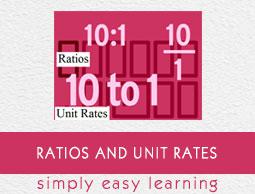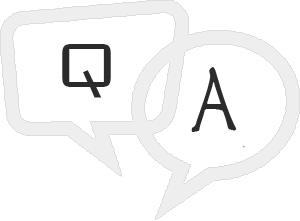Finding Missing Values in a Table of Equivalent Ratios Online Quiz
Following quiz provides Multiple Choice Questions (MCQs) related to Finding Missing Values in a Table of Equivalent Ratios . You will have to read all the given answers and click over the correct answer. If you are not sure about the answer then you can check the answer using Show Answer button. You can use Next Quiz button to check new set of questions in the quiz.
Q 1 - Find the missing values in the following table of equivalent ratios:
Answer : A
Explanation
Step 1:
From the given table of values
$\frac{x}{14} = \frac{2}{7}; x = \frac{2}{7} \times \frac{14}{1} = 4$
Step 2:
$\frac{y}{6} = \frac{7}{2}; y = \frac{7}{2} \times 6 = \frac{7}{2} \times \frac{6}{1} = 21$
Step 3:
So, $x = 4; y = 21$
Show Answer
Q 2 - Find the missing values in the following table of equivalent ratios:
Answer : C
Explanation
Step 1:
From the given table of values
$\frac{x}{12} = \frac{9}{4}; x = \frac{9}{4} \times 12 = \frac{9}{4} \times \frac{12}{1} = 27$
Step 2:
$\frac{y}{36} = \frac{4}{9}; y = \frac{4}{9} \times 36 = \frac{4}{9} \times \frac{36}{1} = 16$
Step 3:
So, $x = 27; y = 16$
Show Answer
Q 3 - Find the missing values in the following table of equivalent ratios:
Answer : B
Explanation
Step 1:
From the given table of values
$\frac{x}{6} = \frac{10}{3}; x = \frac{10}{3} \times 6 = \frac{10}{3} \times \frac{6}{1} = 20$
Step 2:
$\frac{y}{40} = \frac{3}{10}; y = \frac{3}{10} \times 40 = \frac{3}{10} \times \frac{40}{1} = 12$
Step 3:
So, $x = 20; y = 12$
Show Answer
Q 4 - Find the missing values in the following table of equivalent ratios:
Answer : D
Explanation
Step 1:
From the given table of values
$\frac{x}{4} = \frac{9}{2}; x = \frac{9}{2} \times 4 = \frac{9}{2} \times \frac{4}{1} = 18$
Step 2:
$\frac{y}{36} = \frac{2}{9}; y = \frac{2}{9} \times 36 = \frac{2}{9} \times \frac{36}{1} = 8$
Step 3:
So, $x = 18; y = 8$
Show Answer
Q 5 - Find the missing values in the following table of equivalent ratios:
Answer : A
Explanation
Step 1:
From the given table of values
$\frac{x}{21} = \frac{3}{7}; x = \frac{3}{7} \times \frac{21}{1} = \frac{3}{7} \times \frac{21}{1} = 9$
Step 2:
$\frac{y}{12} = \frac{7}{3}; y = \frac{7}{3} \times 12 = \frac{7}{3} \times \frac{12}{1} = 28$
Step 3:
So, $x = 9; y = 28$
Show Answer
Q 6 - Find the missing values in the following table of equivalent ratios:
Answer : D
Explanation
Step 1:
From the given table of values
$\frac{x}{14} = \frac{5}{7}; x = \frac{5}{7} \times 14 = \frac{5}{7} \times \frac{14}{1} = 10$
Step 2:
$\frac{y}{15} = \frac{7}{5}; y = \frac{7}{5} \times 15 = \frac{7}{5} \times \frac{15}{1} = 21$
Step 3:
So, $x = 10; y = 21$
Show Answer
Q 7 - Find the missing values in the following table of equivalent ratios:
Answer : B
Explanation
Step 1:
From the given table of values
$\frac{x}{6} = \frac{3}{2}; x = \frac{3}{2} \times \frac{6}{1} = \frac{3}{2} \times \frac{6}{1} = 9$
Step 2:
$\frac{y}{12} = \frac{2}{3}; y = \frac{2}{3} \times 12 = \frac{2}{3} \times \frac{12}{1} = 8$
Step 3:
So, $x = 9; y = 8$
Show Answer
Q 8 - Find the missing values in the following table of equivalent ratios:
Answer : C
Explanation
Step 1:
From the given table of values
$\frac{x}{10} = \frac{4}{5}; x = \frac{4}{5} \times 10 = \frac{4}{5} \times \frac{10}{1} = 8$
Step 2:
$\frac{y}{12} = \frac{5}{4}; y = \frac{5}{4} \times 12 = \frac{5}{4} \times \frac{12}{1} = 15$
Step 3:
So, $x = 8; y = 15$
Show Answer
Q 9 - Find the missing values in the following table of equivalent ratios:
Answer : C
Explanation
Step 1:
From the given table of values
$\frac{x}{6} = \frac{5}{2}; x = \frac{5}{2} \times 6 = \frac{5}{2} \times \frac{6}{1} = 15$
Step 2:
$\frac{y}{20} = \frac{2}{5}; y = \frac{2}{5} \times 20 = \frac{2}{5} \times \frac{20}{1} = 8$
Step 3:
So, $x = 15; y = 8$
Show Answer
Q 10 - Find the missing values in the following table of equivalent ratios:
Answer : A
Explanation
Step 1:
$\frac{x}{14} = \frac{4}{7}; x = \frac{4}{7} \times 14 = \frac{4}{7} \times \frac{14}{1} = 8$
Step 2:
$\frac{y}{12} = \frac{7}{4}; y = \frac{7}{4} \times 12 = \frac{7}{4} \times \frac{12}{1} = 21$
Step 3:
So, $x = 8; y = 21$
Show Answer
finding_missing_values_table_of_equivalent_ratios.htm



